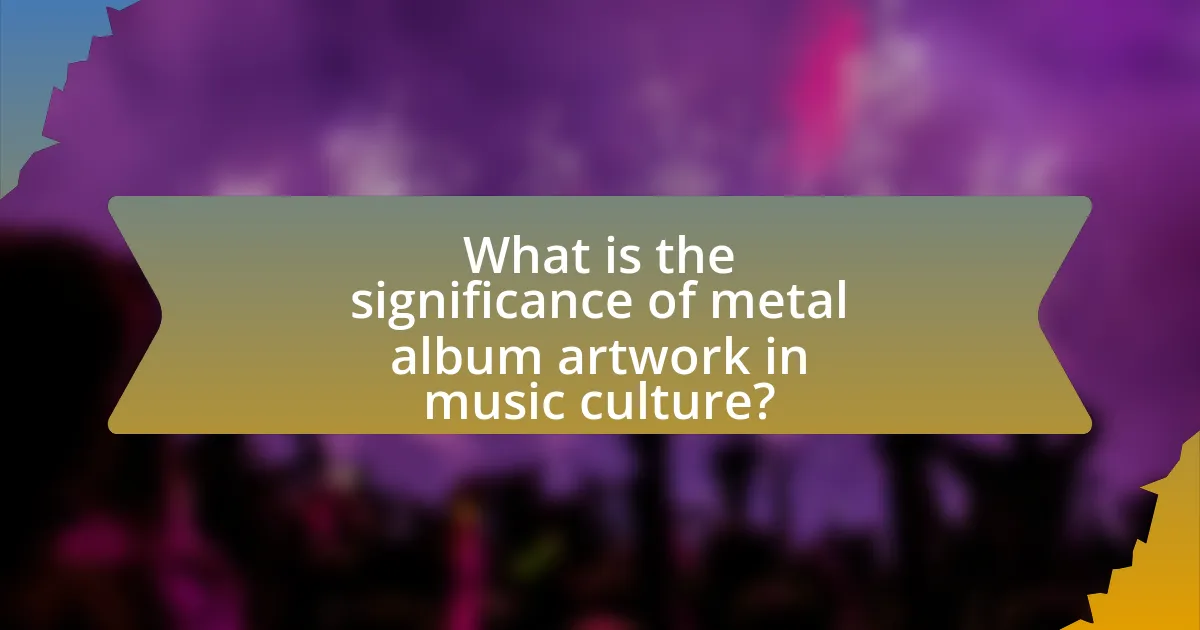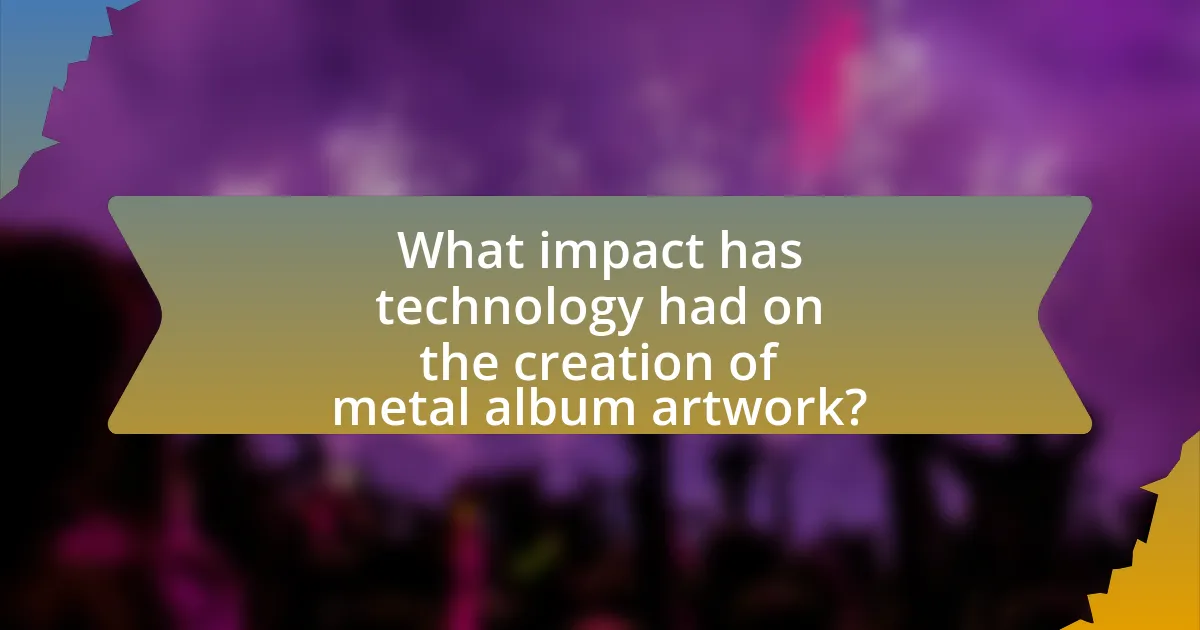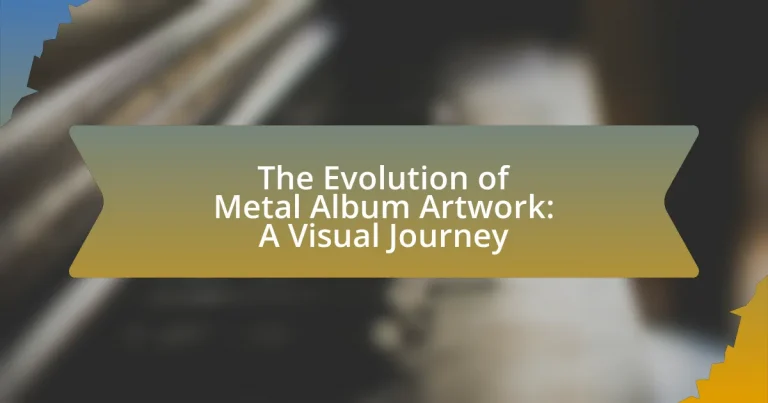The article “The Evolution of Metal Album Artwork: A Visual Journey” examines the significance of metal album artwork within music culture, highlighting its role as a visual representation of a band’s identity and themes. It traces the evolution of album artwork from the surreal and fantasy elements of the 1970s to the digital innovations of the 1990s and 2000s, showcasing how artistic styles and technology have influenced visual representation in metal music. Key elements such as dark themes, intricate details, and the impact of subgenres on artwork styles are discussed, along with the challenges faced by artists in the industry, including copyright issues and the balance between artistic expression and commercial viability. The article emphasizes the importance of album artwork in marketing, sales, and the overall experience of metal music.

What is the significance of metal album artwork in music culture?
Metal album artwork holds significant importance in music culture as it serves as a visual representation of the band’s identity, themes, and musical style. This artwork often reflects the genre’s characteristics, such as darkness, aggression, and fantasy, which resonate with the audience’s emotions and experiences. Historically, iconic album covers like Iron Maiden’s “The Number of the Beast” and Metallica’s “Master of Puppets” have become cultural symbols, influencing not only music fans but also artists across various mediums. The artwork often engages listeners on a deeper level, enhancing the overall experience of the music and contributing to the band’s branding and marketing strategies.
How has metal album artwork evolved over the decades?
Metal album artwork has evolved significantly over the decades, reflecting changes in artistic styles, technology, and cultural influences. In the 1970s, early metal bands like Black Sabbath and Led Zeppelin utilized surreal and psychedelic imagery, often featuring intricate illustrations and fantasy themes. The 1980s saw the rise of heavy metal subgenres, leading to more aggressive and darker artwork, exemplified by Iron Maiden’s iconic Eddie character and the use of vibrant colors and detailed illustrations.
In the 1990s, the advent of digital art transformed album covers, allowing for more complex designs and photo manipulation, as seen in the works of bands like Tool and Nine Inch Nails. The 2000s and beyond have continued this trend, with a blend of traditional and digital techniques, often incorporating minimalist designs or abstract concepts, reflecting the genre’s diversification and the influence of social media on visual presentation.
Overall, the evolution of metal album artwork mirrors the genre’s growth and adaptation, showcasing a dynamic interplay between music and visual art.
What were the defining styles of metal album artwork in the 1970s?
The defining styles of metal album artwork in the 1970s included surrealism, fantasy, and dark themes. Surrealism was prominent, with artists like Roger Dean creating intricate, dreamlike landscapes for bands such as Yes. Fantasy elements often featured mythical creatures and epic scenes, as seen in the artwork for Led Zeppelin’s “Led Zeppelin IV.” Dark themes were also prevalent, with imagery that evoked horror and the macabre, exemplified by Black Sabbath’s self-titled album cover. These styles collectively contributed to the visual identity of heavy metal, reflecting the genre’s rebellious and otherworldly nature.
How did the 1980s influence the visual representation of metal music?
The 1980s significantly influenced the visual representation of metal music through the emergence of iconic album artwork and a distinct aesthetic characterized by bold colors, fantasy themes, and intricate designs. This era saw the rise of artists like Derek Riggs, who created the famous Iron Maiden album covers, which featured detailed illustrations that became synonymous with the band’s identity. Additionally, the use of imagery depicting dark and fantastical elements, such as skulls, demons, and mythical creatures, became prevalent, reflecting the themes of rebellion and escapism in metal music. The popularity of heavy metal during this decade also led to the commercialization of album art, with record labels investing in high-quality graphics to attract fans, further solidifying the visual style associated with the genre.
What changes occurred in the 1990s and 2000s regarding metal album artwork?
In the 1990s and 2000s, metal album artwork transitioned from traditional hand-painted illustrations to digital art and photography. This shift was driven by advancements in technology, allowing artists to create more intricate and detailed designs using software like Adobe Photoshop. Additionally, the rise of the internet facilitated the sharing of artwork and ideas, leading to a broader range of influences and styles in metal album covers. Notably, bands like Metallica and Slipknot embraced these changes, incorporating modern graphic design elements that reflected the evolving sound and culture of metal music during this period.
Why is album artwork considered an essential aspect of metal music?
Album artwork is considered an essential aspect of metal music because it visually represents the themes, emotions, and identity of the genre. The artwork often features dark, intricate designs that resonate with the music’s intensity and lyrical content, enhancing the listener’s experience. For instance, iconic albums like Iron Maiden’s “The Number of the Beast” showcase elaborate illustrations that have become synonymous with the band’s image and the metal genre itself. This visual representation not only attracts fans but also creates a lasting cultural impact, as seen in the widespread recognition of artists like Derek Riggs, who designed many of Iron Maiden’s covers. Thus, album artwork serves as a crucial element in defining the aesthetic and cultural significance of metal music.
How does album artwork contribute to a band’s identity?
Album artwork significantly contributes to a band’s identity by visually representing their music style, themes, and overall brand. This visual representation helps to create a memorable image that fans can associate with the band’s sound and message. For instance, iconic album covers like Iron Maiden’s “The Number of the Beast” not only reflect the band’s heavy metal genre but also encapsulate themes of rebellion and fantasy, reinforcing their identity in the music scene. Furthermore, studies show that album artwork can influence consumer behavior, with 67% of music listeners stating that they are more likely to purchase an album if the cover art is appealing. This connection between visual aesthetics and musical identity underscores the importance of album artwork in establishing and maintaining a band’s presence in the industry.
What role does album artwork play in marketing and sales?
Album artwork plays a crucial role in marketing and sales by serving as a visual representation of the music and brand identity of the artist. It captures attention, conveys themes, and creates an emotional connection with potential listeners, which can significantly influence purchasing decisions. For instance, studies have shown that visually appealing album covers can increase sales by up to 30%, as they enhance the perceived value of the music and attract a wider audience. Additionally, iconic album artwork often becomes synonymous with the artist, reinforcing brand recognition and loyalty over time.

What are the key elements of metal album artwork?
The key elements of metal album artwork include striking imagery, dark themes, and intricate details. Striking imagery often features fantastical or horror-inspired visuals that capture the intensity of the music, while dark themes reflect the genre’s exploration of topics like death, mythology, and rebellion. Intricate details, such as elaborate illustrations or symbolic elements, enhance the visual storytelling and engage the viewer. Historically, iconic metal album covers, like Iron Maiden’s “The Number of the Beast,” exemplify these elements, contributing to the genre’s identity and fan culture.
What visual themes are commonly found in metal album artwork?
Common visual themes in metal album artwork include dark fantasy, horror, and mythology. These themes often feature imagery such as skulls, demons, and apocalyptic landscapes, reflecting the genre’s exploration of darker emotions and existential themes. For instance, iconic albums like Iron Maiden’s “The Number of the Beast” showcase vivid depictions of hellish scenes, while Black Sabbath’s self-titled album presents a haunting atmosphere that aligns with the band’s heavy sound. The prevalence of these themes is supported by the genre’s roots in rebellion and the supernatural, making them a staple in the visual representation of metal music.
How do fantasy and horror elements manifest in metal album covers?
Fantasy and horror elements manifest in metal album covers through vivid imagery, dark themes, and fantastical creatures. These covers often depict scenes of mythical battles, grotesque monsters, and eerie landscapes, which reflect the lyrical content and overall aesthetic of the music. For instance, iconic albums like Iron Maiden’s “The Number of the Beast” feature demonic figures and apocalyptic imagery, reinforcing the horror aspect. Similarly, bands like Blind Guardian incorporate fantasy elements by illustrating epic tales and legendary characters, as seen in their album “Nightfall in Middle-Earth.” This visual representation not only enhances the listener’s experience but also establishes a strong connection between the music and its thematic inspirations, making the artwork an integral part of the metal genre’s identity.
What symbolism is often used in metal album artwork?
Metal album artwork often utilizes symbolism such as death, darkness, and rebellion. These themes reflect the genre’s exploration of existential themes, societal issues, and personal struggles. For instance, imagery of skulls, demons, and mythical creatures frequently appears, representing mortality and the supernatural. Additionally, elements like fire and chaos symbolize destruction and defiance against societal norms. This use of vivid and often provocative imagery serves to evoke strong emotional responses and convey the intensity of the music, aligning with the genre’s overall aesthetic and thematic focus.
How do different subgenres of metal influence album artwork styles?
Different subgenres of metal significantly influence album artwork styles by reflecting their thematic and aesthetic elements. For instance, black metal often features dark, atmospheric imagery with stark contrasts and nature motifs, emphasizing themes of nihilism and anti-establishment, as seen in the artwork of bands like Mayhem. In contrast, power metal typically showcases vibrant, fantastical artwork that includes mythical creatures and epic landscapes, aligning with its themes of heroism and adventure, exemplified by bands like Blind Guardian. Additionally, death metal artwork frequently employs grotesque and macabre visuals, focusing on horror and violence, which is evident in the album covers of Cannibal Corpse. These distinct visual styles not only serve to attract specific audiences but also encapsulate the essence of each subgenre, making album artwork a crucial aspect of metal music’s identity.
What distinguishes the artwork of heavy metal from black metal?
The artwork of heavy metal is characterized by vibrant colors, detailed illustrations, and often fantastical themes, while black metal artwork typically features dark, monochromatic imagery, minimalism, and themes of nihilism or nature. Heavy metal album covers often depict heroic figures, mythical creatures, or elaborate landscapes, reflecting a sense of adventure and escapism. In contrast, black metal artwork tends to use stark contrasts, often with black and white photography or simple graphics, emphasizing a raw and unrefined aesthetic that aligns with the genre’s themes of darkness and anti-establishment. This distinction is evident in iconic album covers, such as Iron Maiden’s “The Number of the Beast” for heavy metal, which showcases vibrant colors and intricate designs, versus Mayhem’s “De Mysteriis Dom Sathanas,” which features a bleak and haunting visual style representative of black metal.
How does the artwork of death metal differ from power metal?
The artwork of death metal differs from power metal primarily in its themes and visual style. Death metal artwork typically features dark, grotesque imagery, often depicting violence, horror, and the macabre, which aligns with the genre’s aggressive sound and lyrical content. In contrast, power metal artwork tends to showcase epic, fantastical themes, often featuring heroic figures, mythical creatures, and vibrant landscapes, reflecting the genre’s more uplifting and melodic nature. This distinction is evident in album covers, where death metal bands like Cannibal Corpse use graphic illustrations of decay and brutality, while power metal bands like Blind Guardian utilize colorful, intricate designs that evoke a sense of adventure and fantasy.

What impact has technology had on the creation of metal album artwork?
Technology has significantly transformed the creation of metal album artwork by enabling artists to utilize advanced digital tools and software for design. The introduction of graphic design software like Adobe Photoshop and Illustrator has allowed for greater precision, creativity, and experimentation in visual styles, leading to more intricate and visually striking album covers. Additionally, the accessibility of digital art tools has democratized the creation process, allowing independent artists to produce professional-quality artwork without the need for expensive resources. This shift has resulted in a diverse range of artistic expressions within the metal genre, reflecting the evolving aesthetics and themes of the music itself.
How has digital art changed the landscape of album cover design?
Digital art has revolutionized album cover design by enabling artists to create intricate, high-resolution visuals that were previously unattainable with traditional methods. This shift has allowed for greater experimentation with styles, colors, and textures, resulting in more diverse and visually striking album covers. For instance, the use of software like Adobe Photoshop and Illustrator has facilitated the blending of photography and digital painting, leading to unique compositions that enhance the thematic elements of the music. Additionally, the accessibility of digital tools has democratized the design process, allowing independent artists to produce professional-quality artwork without the need for expensive resources. This transformation is evident in the metal genre, where album covers often feature complex imagery that reflects the music’s intensity and themes, showcasing the significant impact of digital art on visual representation in the music industry.
What tools and software are commonly used by artists today?
Artists today commonly use digital tools and software such as Adobe Photoshop, Illustrator, Procreate, and Corel Painter for creating artwork. Adobe Photoshop is widely recognized for its powerful image editing capabilities, while Illustrator is favored for vector graphics. Procreate has gained popularity among digital illustrators for its intuitive interface on iPad, and Corel Painter is known for its realistic brush simulation. These tools enable artists to produce high-quality, detailed artwork efficiently, reflecting the technological advancements in the art field.
How does social media influence the promotion of album artwork?
Social media significantly influences the promotion of album artwork by providing artists and labels with direct access to a global audience. Platforms like Instagram, Twitter, and Facebook allow musicians to share high-quality images of their album covers, engage with fans, and create buzz around upcoming releases. For instance, a study by the Pew Research Center indicates that 72% of adults use at least one social media site, which amplifies the reach of promotional content. Additionally, the visual nature of platforms like Instagram enhances the impact of album artwork, as users are more likely to share visually appealing content, leading to increased visibility and engagement. This dynamic interaction fosters a community around the artwork, encouraging discussions and shares that further promote the album.
What are the challenges faced by artists in the metal album artwork industry?
Artists in the metal album artwork industry face several challenges, including the need to balance artistic expression with commercial viability. The demand for unique and striking visuals often conflicts with the expectations of record labels and audiences, leading to creative constraints. Additionally, artists must navigate the competitive landscape, where many seek to establish their identity while adhering to genre conventions. Financial instability is another significant challenge, as many artists struggle to secure consistent work or fair compensation for their efforts. Furthermore, the rise of digital media has shifted the focus from physical album covers to online formats, diminishing the perceived value of their artwork. These factors collectively hinder artists’ ability to thrive in the metal album artwork industry.
How do copyright issues affect the creation of album covers?
Copyright issues significantly impact the creation of album covers by restricting the use of existing artwork, images, and designs without proper licensing or permission. Artists and designers must navigate copyright laws to avoid legal disputes, which can lead to costly litigation or the need to redesign covers entirely. For instance, using a famous painting or photograph without authorization can result in infringement claims, as seen in cases like the lawsuit involving the band Metallica and the use of a photograph by a well-known artist. This legal framework necessitates that creators either seek licenses for existing works or produce original content, thereby influencing the artistic direction and financial considerations of album cover design.
What are the common misconceptions about metal album artwork?
Common misconceptions about metal album artwork include the belief that it solely promotes violence and negativity. In reality, many metal album covers explore themes of fantasy, mythology, and personal struggle, reflecting a wide range of artistic expression. Additionally, some people assume that all metal artwork is dark and grotesque; however, numerous subgenres feature vibrant and intricate designs that celebrate life and creativity. For instance, the artwork of bands like Nightwish and Symphony X often incorporates elaborate fantasy elements, showcasing a different aesthetic within the metal genre.
What are some best practices for creating impactful metal album artwork?
To create impactful metal album artwork, artists should focus on strong visual themes that resonate with the genre’s intensity and emotion. Utilizing bold colors, intricate details, and symbolic imagery can effectively convey the music’s themes and atmosphere. For instance, iconic metal album covers often feature dark fantasy elements, mythical creatures, or apocalyptic scenes, which align with the lyrical content and overall aesthetic of the genre.
Additionally, collaborating with experienced illustrators or graphic designers who understand metal culture can enhance the artwork’s authenticity and appeal. Historical examples, such as Iron Maiden’s “The Number of the Beast” cover by Derek Riggs, demonstrate how memorable artwork can become synonymous with the band’s identity and music. This connection between visual art and musical expression is crucial for creating a lasting impact in the metal community.
How can artists effectively communicate a band’s message through visuals?
Artists can effectively communicate a band’s message through visuals by aligning imagery with the band’s themes, emotions, and musical style. For instance, using color schemes, symbols, and visual metaphors that resonate with the band’s lyrics or overall aesthetic can create a cohesive narrative. Research indicates that album artwork significantly influences listener perception; a study by the University of Southern California found that 70% of consumers associate visual elements with their emotional response to music. This demonstrates that well-crafted visuals can enhance the band’s message and deepen audience engagement.
What tips can be offered for aspiring metal album cover designers?
Aspiring metal album cover designers should focus on understanding the genre’s themes and aesthetics to create impactful artwork. Familiarizing oneself with iconic metal album covers, such as Iron Maiden’s “The Number of the Beast” or Metallica’s “Master of Puppets,” can provide insight into effective visual storytelling and the use of symbolism. Additionally, mastering digital art tools like Adobe Photoshop and Illustrator is crucial, as these programs are industry standards for creating high-quality designs. Engaging with the metal community through social media platforms and forums can also provide valuable feedback and networking opportunities, which are essential for career growth in this niche field.


